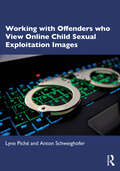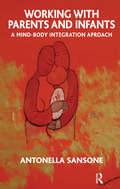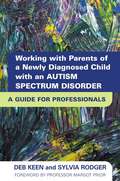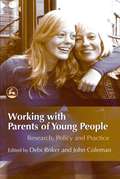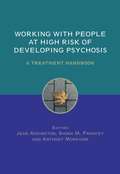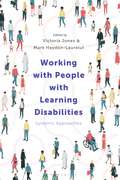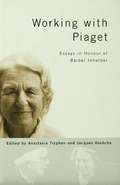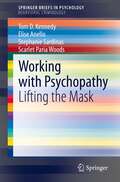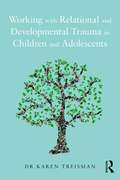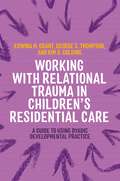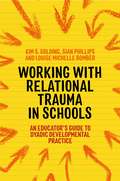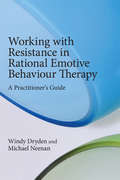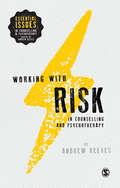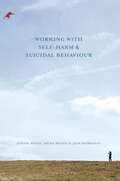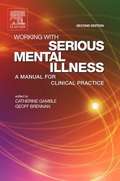- Table View
- List View
Working with Offenders who View Online Child Sexual Exploitation Images
by Lyne Piché Anton SchweighoferThis comprehensive workbook addresses the use of illegal online sexual images. Focusing specifically on child sexual exploitation materials (CSEM), it offers a clear and professional manual for use with men who use CSEM. Working with clients who access illegal online images is challenging work. CSEM clients have unique characteristics and treatment needs. Designed around practitioner and client needs, each chapter provides a guide for clinicians and a subsequent set of materials for the client. The workbook covers a range of topics such as motivation for change, relationships, thinking patterns, emotions management, sexuality, computer use, Internet safety and future strategies to ensure both client and community safety. Addressing these issues as well as community accountability helps users of CSEM achieve a satisfying life while avoiding future criminal justice involvement. Through this clearly written and structured workbook, clients are given the resources to help manage problematic thoughts and/or illegal sexual behaviour. Offering evidence-based strategies rooted in the authors’ clinical experiences, the workbook enables the practitioner and client to work productively together to address the issues that have led to their involvement with illegal sexual images. This book will be helpful to a range of practitioners including forensic and clinical psychologists, as well as those working in correctional settings, such as probation and prison staff, psychiatrists, social workers, counsellors and providers of mental health treatment. It is also designed for anyone who has viewed, or is worried about viewing, sexual images of children.
Working with Parents and Infants: A Mind-Body Integration Approach
by Antonella SansoneWorking with Parents and Infants is aimed at understanding the process of psychosomatic illness, exploring the embodiment of psychosomatic health and illness, and the inseparability of psyche and soma. Within this book, the author highlights the beneficial function of psychosomatic symptoms, such as mastitis, in signalling to the counsellor or therapist as well as the patient the need for change and the path through which it may occur. Research and clinical literature have often overlooked the relationship between the woman's attitude to her bodyself, thus her mind-body integration, breastfeeding and the quality of interactions with her baby. A psychosomatic disturbance is in this book conceived as an impaired sense of bodyself, or in other words, a lack of psycho-soma integration. The author presents a new approach to health and the healing relationship emerging from a meeting between Eastern meditative disciplines and Western psychological practise.
Working with Parents and Infants: A Mind-Body Integration Approach
by Antonella SansoneWorking with Parents and Infants is aimed at understanding the process of psychosomatic illness, exploring the embodiment of psychosomatic health and illness, and the inseparability of psyche and soma. Within this book, the author highlights the beneficial function of psychosomatic symptoms, such as mastitis, in signalling to the counsellor or therapist as well as the patient the need for change and the path through which it may occur. Research and clinical literature have often overlooked the relationship between the woman's attitude to her bodyself, thus her mind-body integration, breastfeeding and the quality of interactions with her baby. A psychosomatic disturbance is in this book conceived as an impaired sense of bodyself, or in other words, a lack of psycho-soma integration. The author presents a new approach to health and the healing relationship emerging from a meeting between Eastern meditative disciplines and Western psychological practise.
Working with Parents of a Newly Diagnosed Child with an Autism Spectrum Disorder: A Guide for Professionals
by Deb Keen Sylvia RodgerFinding out that a child has an autism spectrum disorder (ASD) can put an enormous strain on families, and the quality of support offered by professionals at this time can make a huge difference to how they adjust to the news. This book comprehensively sets out the type of support that is most beneficial to families immediately following an ASD diagnosis, and will equip professionals with the information and tools they need to best provide that support. The authors provide all of the key information professionals supporting families at the time of an ASD diagnosis need to know about the diagnostic criteria of ASD, key characteristics, aetiology, prevalence, and prognosis, and explain how to pass on accurate and meaningful information to families, and how to build effective family-professional partnerships. Drawing on extensive research and interviews with 50 families of children with ASD, they provide strategies for helping families understand the options and make informed choices about early intervention programs, set realistic goals, develop effective parenting strategies that build upon the strengths and capacities of the child, and strengthen family support networks. This is an essential resource for any professional involved in supporting families at the time of, or immediately following, an ASD diagnosis, including psychologists, occupational therapists, speech and language therapists, general medical practitioners, and educators.
Working with Parents of a Newly Diagnosed Child with an Autism Spectrum Disorder: A Guide for Professionals (PDF)
by Deb Keen Sylvia RodgerFinding out that a child has an autism spectrum disorder (ASD) can put an enormous strain on families, and the quality of support offered by professionals at this time can make a huge difference to how they adjust to the news. This book comprehensively sets out the type of support that is most beneficial to families immediately following an ASD diagnosis, and will equip professionals with the information and tools they need to best provide that support. The authors provide all of the key information professionals supporting families at the time of an ASD diagnosis need to know about the diagnostic criteria of ASD, key characteristics, aetiology, prevalence, and prognosis, and explain how to pass on accurate and meaningful information to families, and how to build effective family-professional partnerships. Drawing on extensive research and interviews with 50 families of children with ASD, they provide strategies for helping families understand the options and make informed choices about early intervention programs, set realistic goals, develop effective parenting strategies that build upon the strengths and capacities of the child, and strengthen family support networks. This is an essential resource for any professional involved in supporting families at the time of, or immediately following, an ASD diagnosis, including psychologists, occupational therapists, speech and language therapists, general medical practitioners, and educators.
Working with Parents of Young People: Research, Policy and Practice
by Amanda Holt Cris Hoskin Debi Roker Helen Richardon Foster Helen Richardson Foster John Coleman Julie Shepherd Kerry Devitt Kevin Lowe Lester Coleman Louise Cox Nigel Sherriff Sarah Lindfield Stephanie StaceThis book provides practical guidance for a wide range of professionals working with parents and families, answering common questions such as 'How can parents facilitate their child's transition to secondary school?' and 'How can families best communicate about alcohol?'. Drawing on the findings from years of applied research projects carried out by the Trust for the Study of Adolescence, each chapter focuses on a particular area of parenting young people - from monitoring and supervision to support for foster families - and each highlights the implications of research results for policy and practice. This book presents a range of approaches to working with parents and families, and discusses the effectiveness of techniques such as parent mentoring and involving young people in parenting programmes. Working with Parents of Young People provides a strong set of evidence-based guidelines for best practice and will be a key resource for all those working to support the parents of teenagers.
Working with Parents of Young People: Research, Policy and Practice (PDF)
by Amanda Holt Cris Hoskin Debi Roker Helen Richardon Foster Helen Richardson Foster John Coleman Julie Shepherd Kerry Devitt Kevin Lowe Lester Coleman Louise Cox Nigel Sherriff Sarah Lindfield Stephanie StaceThis book provides practical guidance for a wide range of professionals working with parents and families, answering common questions such as 'How can parents facilitate their child's transition to secondary school?' and 'How can families best communicate about alcohol?'. Drawing on the findings from years of applied research projects carried out by the Trust for the Study of Adolescence, each chapter focuses on a particular area of parenting young people - from monitoring and supervision to support for foster families - and each highlights the implications of research results for policy and practice. This book presents a range of approaches to working with parents and families, and discusses the effectiveness of techniques such as parent mentoring and involving young people in parenting programmes. Working with Parents of Young People provides a strong set of evidence-based guidelines for best practice and will be a key resource for all those working to support the parents of teenagers.
Working with People at High Risk of Developing Psychosis: A Treatment Handbook
by Jean Addington Shona Francey Anthony P. MorrisonA timely overview of new psychological interventions in this exciting and emerging field, Working with People at High Risk of Developing Psychosis: A Treatment Handbook presents the most up-to-date progress in the identification of individuals who are at ultra high risk of developing a psychotic illness. The book focuses on a range of psychological interventions that are currently being developed, tested, and used in order to alleviate these early symptoms and attempt to delay or even prevent the onset of a psychotic illness. Even for those who will not go on to develop an illness, such interventions are helpful in the alleviation of their presenting symptoms. This practical treatment handbook addresses a wide range of issues presented by "at risk" clients. Specific chapters, written by experts in that particular area, cover stress management, co-morbidity, substance misuse, family work and group therapy.
Working with People with Learning Disabilities: Systemic Approaches
by Victoria Jones Mark Haydon-LaurelutThis multi-disciplinary textbook provides a comprehensive guide for anyone working with people with learning disabilities. It considers how we can engage with people with learning disabilities and their networks of relationships. Throughout, the book demonstrates how theory can be applied to practice with a wide range of contemporary examples.Each chapter is written by a key clinician or writer in this area, incorporating the disciplines of nursing, clinical psychology, and psychotherapy. The chapters also include summaries, reflective questions and explanations of key terms to reinforce themes and topics. The authors provide practical ideas for applying theory across agency contexts including inpatient hospital settings and explore the potential opportunities and future directions for the field.This is a must-read book for students who work with people with learning disabilities including nurses, psychologists, occupational therapists, speech and language therapists, psychiatrists and social workers.
Working with People with Learning Disabilities: Systemic Approaches
by Victoria Jones and Mark Haydon-LaurelutThis multi-disciplinary textbook provides a comprehensive guide for anyone working with people with learning disabilities. It considers how we can engage with people with learning disabilities and their networks of relationships. Throughout, the book demonstrates how theory can be applied to practice with a wide range of contemporary examples.Each chapter is written by a key clinician or writer in this area, incorporating the disciplines of nursing, clinical psychology, and psychotherapy. The chapters also include summaries, reflective questions and explanations of key terms to reinforce themes and topics. The authors provide practical ideas for applying theory across agency contexts including inpatient hospital settings and explore the potential opportunities and future directions for the field.This is a must-read book for students who work with people with learning disabilities including nurses, psychologists, occupational therapists, speech and language therapists, psychiatrists and social workers.
Working with Piaget: Essays in Honour of Barbel Inhelder
by Anastasia Tryphon Jacques VonecheFor fifty years Bärbel Inhelder (1913-1997) was the research companion of Jean Piaget. In this unique volume, published in her honour, leading international researchers examine the various aspects of her work and ideas and her contribution to developmental psychology. Following an initial chapter establishing Inhelder's stature as an independent researcher in her own right, the various research topics that she explored are reviewed and discussed with specific reference to her own perspective and in the chronological order in which she approached them. While the book explores Inhelder's work with her more famous colleague, it also highlights areas of research in which her ideas were at variance with those of Piaget, such as mental imagery, and areas in which her innovations have not been fully recognised, such as her discovery of the formal operations stage - an event usually attributed to Piaget - and her introduction of longitudinal studies in the field of cognitive development. Her research, viewpoint and contribution in other fields such as mental retardation, learning, and cross-cultural issues in development are also discussed. The final chapter, written by Inhelder herself, deals with experimental reasoning in children and adolescents and provides a glimpse of her creativity.
Working with Piaget: Essays in Honour of Barbel Inhelder
by Anastasia Tryphon Jacques VonècheFor fifty years Bärbel Inhelder (1913-1997) was the research companion of Jean Piaget. In this unique volume, published in her honour, leading international researchers examine the various aspects of her work and ideas and her contribution to developmental psychology. Following an initial chapter establishing Inhelder's stature as an independent researcher in her own right, the various research topics that she explored are reviewed and discussed with specific reference to her own perspective and in the chronological order in which she approached them. While the book explores Inhelder's work with her more famous colleague, it also highlights areas of research in which her ideas were at variance with those of Piaget, such as mental imagery, and areas in which her innovations have not been fully recognised, such as her discovery of the formal operations stage - an event usually attributed to Piaget - and her introduction of longitudinal studies in the field of cognitive development. Her research, viewpoint and contribution in other fields such as mental retardation, learning, and cross-cultural issues in development are also discussed. The final chapter, written by Inhelder herself, deals with experimental reasoning in children and adolescents and provides a glimpse of her creativity.
Working with Psychopathy: Lifting the Mask (SpringerBriefs in Psychology)
by Tom D. Kennedy Elise Anello Stephanie Sardinas Scarlet Paria WoodsThis brief explores the research on psychopaths in various settings and in everyday life. Psychopaths are often predatory by nature but may appear normal to laypersons. Individuals working in health professions, forensic occupations, education and corporate environments are likely to encounter a person with psychopathic traits at some point in their respective careers; this brief highlights the value of being able to identify a person with psychopathic traits, to understand the implications, and to navigate any interactions. With recommendations for assessment and for guiding future interactions, this brief will be beneficial to mental health professionals, practitioners and researchers in psychology, forensic occupations, corrections, education, healthcare, and professionals in corporate environments.
Working with Relational and Developmental Trauma in Children and Adolescents
by Karen TreismanWorking with Relational and Developmental Trauma in Children and Adolescents focuses on the multi-layered complex and dynamic area of trauma, loss and disrupted attachment on babies, children, adolescents and the systems around them. The book explores the impact of relational and developmental trauma and toxic stress on children’s bodies, brains, relationships, behaviours, cognitions, and emotions. The book draws on a range of theoretical perspectives through reflective exercises, rich case studies, practical applications and therapeutic strategies. With chapters on wider organisational and systemic dynamics, strength-based practices and the intergenerational transmission of relational trauma, Karen Treisman provides a holistic view of the pervasive nature and impact of working with trauma. Working with Relational and Developmental Trauma in Children and Adolescents will be of interest to professionals working with children and families in the community, in-patient, school, residential, and court-based settings, including clinical psychologists, psychiatrists, social workers, teachers, and students.
Working with Relational and Developmental Trauma in Children and Adolescents
by Karen TreismanWorking with Relational and Developmental Trauma in Children and Adolescents focuses on the multi-layered complex and dynamic area of trauma, loss and disrupted attachment on babies, children, adolescents and the systems around them. The book explores the impact of relational and developmental trauma and toxic stress on children’s bodies, brains, relationships, behaviours, cognitions, and emotions. The book draws on a range of theoretical perspectives through reflective exercises, rich case studies, practical applications and therapeutic strategies. With chapters on wider organisational and systemic dynamics, strength-based practices and the intergenerational transmission of relational trauma, Karen Treisman provides a holistic view of the pervasive nature and impact of working with trauma. Working with Relational and Developmental Trauma in Children and Adolescents will be of interest to professionals working with children and families in the community, in-patient, school, residential, and court-based settings, including clinical psychologists, psychiatrists, social workers, teachers, and students.
Working with Relational Trauma in Children's Residential Care: A Guide to Using Dyadic Developmental Practice (Guides to Working with Relational Trauma Using DDP)
by Kim S. Golding George Thompson Edwina GrantDyadic Developmental Psychotherapy (DDP) is a therapeutic approach, based in attachment theory, which is used to support children who have experienced relational trauma. By consciously offering PACE (playfulness, acceptance, curiosity, and empathy), adults can help children - and each other - to feel more secure and open to others. This guide provides an overview of DDP and explores how it can be used to support children in residential care settings. Case studies, examples, and expert guidance from the authors' extensive experience demonstrate how to apply the principles of DDP to daily practice. From integrating the PACE model into conversations - both with children and colleagues - to balancing physical safety with relational safety in secure care situations, this book offers a way to build a culture of support throughout the whole structure of residential care settings.
Working with Relational Trauma in Schools: An Educator's Guide to Using Dyadic Developmental Practice (Guides to Working with Relational Trauma Using DDP)
by Louise Michelle Bombèr Kim Golding Sian PhillipsWritten by experienced clinicians, this book provides an exploration of how educators can easily use Dyadic Developmental Practice (DDP) to help vulnerable pupils to thrive.DDP is an intervention model for children and young people who have experienced trauma in past relationships. Safety and security is increased through offering emotional connection in a variety of ways, helped by the attitude of PACE (playfulness, acceptance, curiosity and empathy). The model gives children the opportunity to experience the relationships necessary for healthy development, emotional regulation and resilience. This book gives educators all the tools they need to embed DDP into their practice, including building connections with students, partnerships with parents, understanding the theory behind DDP, and overcoming the challenges of implementing it in practice. These principles can be adapted to support pupils at all levels.
Working with Relational Trauma in Schools: An Educator's Guide to Using Dyadic Developmental Practice (Guides to Working with Relational Trauma Using DDP)
by Louise Michelle Bombèr Kim Golding Sian PhillipsWritten by experienced clinicians, this book provides an exploration of how educators can easily use Dyadic Developmental Practice (DDP) to help vulnerable pupils to thrive.DDP is an intervention model for children and young people who have experienced trauma in past relationships. Safety and security is increased through offering emotional connection in a variety of ways, helped by the attitude of PACE (playfulness, acceptance, curiosity and empathy). The model gives children the opportunity to experience the relationships necessary for healthy development, emotional regulation and resilience. This book gives educators all the tools they need to embed DDP into their practice, including building connections with students, partnerships with parents, understanding the theory behind DDP, and overcoming the challenges of implementing it in practice. These principles can be adapted to support pupils at all levels.
Working with Resistance in Rational Emotive Behaviour Therapy: A Practitioner's Guide
by Windy Dryden Michael NeenanProductive therapeutic change is facilitated when the therapist and client have a good therapeutic relationship, share views on salient therapeutic matters, agree on goals to enhance client well-being, and understand what they each have to do to achieve the goals of therapy. In this book Windy Dryden and Michael Neenan address the difficulties that both client and therapist bring to rational emotive behaviour therapy (REBT) when either party is resistant to change. Divided into two parts, Client Resistance and Therapist Resistance, Working with Resistance in Rational Emotive Behaviour Therapy tackles the challenges experienced by both client and clinician when using REBT. Addressing issues of resistance enables both the client and practitioner to move beyond problems in the consulting room and build a more productive relationship, resulting in more effective sessions and assisting in the resolution of underlying problems for which the client has sought help. Working with Resistance in Rational Emotive Behaviour Therapy is essential reading for any practitioner hoping to use REBT more effectively in their day-to-day practice.
Working with Resistance in Rational Emotive Behaviour Therapy: A Practitioner's Guide
by Windy Dryden Michael NeenanProductive therapeutic change is facilitated when the therapist and client have a good therapeutic relationship, share views on salient therapeutic matters, agree on goals to enhance client well-being, and understand what they each have to do to achieve the goals of therapy. In this book Windy Dryden and Michael Neenan address the difficulties that both client and therapist bring to rational emotive behaviour therapy (REBT) when either party is resistant to change. Divided into two parts, Client Resistance and Therapist Resistance, Working with Resistance in Rational Emotive Behaviour Therapy tackles the challenges experienced by both client and clinician when using REBT. Addressing issues of resistance enables both the client and practitioner to move beyond problems in the consulting room and build a more productive relationship, resulting in more effective sessions and assisting in the resolution of underlying problems for which the client has sought help. Working with Resistance in Rational Emotive Behaviour Therapy is essential reading for any practitioner hoping to use REBT more effectively in their day-to-day practice.
Working with Risk in Counselling and Psychotherapy
by Dr Andrew ReevesThe wide-ranging contexts in which counselling and psychotherapy is now practiced means clients present with a range of risks that therapists have to respond to. Risk is an ever-present issue for counsellors and psychotherapists and, in an increasingly litigious culture, the need for trainees to develop a sound understanding of how the right tools and the right knowledge can support their practice has never been greater. In this book Andrew Reeves takes trainees, newly qualified practitioners, and more experienced practitioners step-by-step through what is meant by risk, offering practical hints and tips and links to policy and research to inform good ethical practice along the way. This book tackles: • The definition of risk and how risk is linked to social, psychological and relational factors • Working with those who are at risk of suicide, self-injury, self-harm and/or are an endangerment to others • How therapists should respond to the risk in situations involving child protection, mental health crises, and in the therapeutic process itself • The positive side of risk-taking • How counsellors and psychotherapists can work with risk proactively and positively, informed by research. Filled with case studies, ethical dilemmas, reflective questions, discussion questions and further reading, this book offers counsellors and psychotherapists guidance on how they can work with risk proactively and positively. It is an essential resource for all services, organisations and individual practitioners.
Working with Risk in Counselling and Psychotherapy (PDF)
by Dr Andrew ReevesThe wide-ranging contexts in which counselling and psychotherapy is now practiced means clients present with a range of risks that therapists have to respond to. Risk is an ever-present issue for counsellors and psychotherapists and, in an increasingly litigious culture, the need for trainees to develop a sound understanding of how the right tools and the right knowledge can support their practice has never been greater. In this book Andrew Reeves takes trainees, newly qualified practitioners, and more experienced practitioners step-by-step through what is meant by risk, offering practical hints and tips and links to policy and research to inform good ethical practice along the way. This book tackles: • The definition of risk and how risk is linked to social, psychological and relational factors • Working with those who are at risk of suicide, self-injury, self-harm and/or are an endangerment to others • How therapists should respond to the risk in situations involving child protection, mental health crises, and in the therapeutic process itself • The positive side of risk-taking • How counsellors and psychotherapists can work with risk proactively and positively, informed by research. Filled with case studies, ethical dilemmas, reflective questions, discussion questions and further reading, this book offers counsellors and psychotherapists guidance on how they can work with risk proactively and positively. It is an essential resource for all services, organisations and individual practitioners.
Working With Self Harm and Suicidal Behaviour
by Louise Doyle Brian Keogh Jean MorrisseySuicide and self-harm are world-wide public health issues that can have devastating effects on families, friends and communities. They are both a priority for anyone working in mental health, social work, emergency departments and related fields, however suicidal and self-harming behaviour can take place anywhere anytime - it may be a pupil in a school, an inmate in a prison or a colleague or family member. For this reason, this book has been written in a clear, accessible and practical style for anyone who wants to learn more about working with and preventing suicidal and self-harming behaviour.- It identifies common risk and protective factors as well as specific warning signs of imminent suicidal behaviour- It provides essential communication skills for undertaking a risk assessment, illustrating how each skill can be used in real-life practice.- It looks specifically at the issue of self-harm and suicide in prisons, schools and emergency departments- It lays out clear strategies for identifying and addressing issues of self-care when working with people who are suicidal or who self-harm- It identifies how we can assist those who are bereaved following the death of a loved one by suicidePacked with learning outcomes, case scenarios and reflective questions, this book acts as a toolkit for anyone working in this difficult field.
Working With Self Harm and Suicidal Behaviour
by Jean Morrissey Louise Doyle Brian KeoghSuicide and self-harm are world-wide public health issues that can have devastating effects on families, friends and communities. They are both a priority for anyone working in mental health, social work, emergency departments and related fields, however suicidal and self-harming behaviour can take place anywhere anytime- it may be a pupil in a school, an inmate in a prison or a colleague or family member. For this reason, this book has been written in a clear, accessible and practical style for anyone who wants to learn more about working with and preventing suicidal and self-harming behaviour. • It identifies common risk and protective factors as well as specific warning signs of imminent suicidal behaviour.• It provides essential communication skills for undertaking a risk assessment, illustrating how each skill can be used in real-life practice.• It looks specifically at the issue of self-harm and suicide in prisons, schools and emergency departments.• It lays out clear strategies for identifying and addressing issues of self-care when working with people who are suicidal or who self-harm.• It identifies how we can assist those who are bereaved following the death of a loved one by suicide.Packed with learning outcomes, case scenarios and reflective questions, this book acts as a toolkit for anyone working in this difficult field.
Working With Serious Mental Illness: A Manual For Clinical Practice
by Catherine Gamble Geoff BrennanThis title is directed primarily towards health care professionals outside of the United States. In today's mental health services, there is a pressing need for practitioners to place greater emphasis on working with users of services and to use skills that have a sound theoretical basis. This book focuses on evidence-based practice but reflects that, in mental health, the best evidence is the personal experience of the user. Many publications explore theoretical aspects of service delivery or provide an in-depth analysis of specific clinical interventions. However, how practitioners comprehensively amalgamate theory with their practice is often missing. This book fills that gap and seeks to guide, plan and suggest down-to-earth treatment ideas for individuals on a day-to-day basis. Mental health practice focused Full of practical advice, user-friendly, clearly accessible and well-designed Reflects user-input, including a chapter written by a user of mental health services describing their experiences of mental illness Leading contributors from practice Early intervention Supervision Implementation and practice development issues Meaningful activity and recovery Engaging and working with carers Relapse prevention
